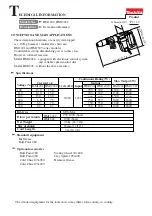
6
ENGLISH
(Original instructions)
Safety of others
● This appliance can be used by children aged from 8 years
and above and persons with reduced physical, sensory or
mental capabilities or lack of experience and knowledge if
they have been given supervision or instruction
concerning use of the appliance in a safe way and
understand the hazards involved.
● Children shall not play with the appliance. Cleaning and
user maintenance shall not be made by children without
supervision.
Residual risks
Additional residual risks may arise when using the tool which
may not be included in the enclosed safety warnings. These
risks can arise from misuse, prolonged use etc.
Even with the application of the relevant safety regulations
and the implementation of safety devices, certain residual
risks can not be avoided. These include:
● Injuries caused by touching any rotating/moving parts.
● Injuries caused when changing any parts, blades or
accessories.
● Injuries caused by prolonged use of a tool. When using
any tool for prolonged periods ensure you take regular
breaks.
● Impairment of hearing.
● Health hazards caused by breathing dust developed when
using your tool (example:- working with wood, especially
oak, beech and MDF.)
Vibration
The declared vibration emission values stated in the technical
data and the declaration of conformity have been measured in
accordance with a standard test method provided by EN62841
and may be used for comparing one tool with another. The
declared vibration emission value may also be used in a
preliminary assessment of exposure.
@
Warning!
The vibration emission value during actual
use of the power tool can differ from the declared
value depending on the ways in which the tool is
used. The vibration level may increase above the
level stated.
When assessing vibration exposure to determine safety
measures required by 2002/44/EC to protect persons regularly
using power tools in employment, an estimation of vibration
exposure should consider, the actual conditions of use and the
way the tool is used, including taking account of all parts of
the operating cycle such as the times when the tool is
switched off and when it is running idle in addition to the
trigger time.
Labels on tool
The following symbols are shown on the tool along with the
date code:
:
Warning!
To reduce the risk of injury, the user
must read the instruction manual.
Additional safety instructions for batteries and
chargers
Batteries
● Never attempt to open for any reason.
● Do not expose the battery to water.
● Do not expose the battery to heat.
● Do not store in locations where the temperature may
exceed 40 °C.
● Charge only at ambient temperatures between 10 °C and
40 °C.
● Charge only using the charger provided with the
appliance/tool.
● When disposing of batteries, follow the instructions given
in the section “Protecting the environment”.
● Do not damage/deform the battery pack either by puncture
or impact, as this may create a risk of injury and fire.
● Do not charge damaged batteries.
● Under extreme conditions, battery leakage may occur.
When you notice liquid on the batteries carefully wipe the
liquid off using a cloth. Avoid skin contact.
● In case of skin or eye contact, follow the instructions
below.
@
Warning!
The battery fluid may cause personal injury
or damage to property. In case of skin contact,
immediately rinse with water. If redness, pain or
irritation occurs seek medical attention. In case of
eye contact, rinse immediately with clean water and
seek medical attention.
Chargers
Your charger has been designed for a specific voltage. Always
check that the mains voltage corresponds to the voltage on
the rating plate.
@
Warning!
Never attempt to replace the charger unit
with a regular mains plug.
● Use your charger only to charge the battery in the tool with
which it was supplied. Other batteries could burst, causing
personal injury and damage.
● Never attempt to charge non-rechargeable batteries.
● If the supply cord is damaged, it must be replaced by the
manufacturer or an authorised Service Centre in order to
avoid a hazard.
● Have defective cords replaced immediately.
● Do not expose the charger to water.
Содержание Fatmax SFMCH900 Series
Страница 1: ...www stanley eu 1 3 4 5 6 7 2 SFMCH900...
Страница 2: ...2 7 8 8b 8a A 7 7a B 7 C 7b 7 D 10 11 E...
Страница 11: ...11 P STANLEY FATMAX SFMCH900 SDS 1 a b c 2 a b c d e f 3 a b c...
Страница 12: ...12 P d e f g h 4 a b c d e f g h 5 a b c...
Страница 13: ...13 P d e f 130 C 130 C 265 F g 6 a b...
Страница 14: ...14 P 8 EN62841 2002 44 EC 40 C 10 C 40 C...
Страница 21: ...21 P...
Страница 22: ...22 P...
Страница 23: ...23 SFMCH900 STANLEY FAT MAX SDS 1 a b c 2 a b c d e f Residual current device RCD RCD 3 a b c d...
Страница 24: ...24 e f g h 4 a b c d e f g h 5 a b c d e...
Страница 25: ...25 f 130 C 130 C 265 F g 6 a b 8...
Страница 26: ...26 EN62841 2002 44 EC 40 C 10 C 40 C...
Страница 31: ...31...
Страница 32: ...32...
Страница 33: ......
Страница 34: ......
Страница 35: ......
Страница 36: ...530915 74 RUS UA 03 2021...







































